Who are SDRs (Sales Development Representatives)? What do they do? How do they contribute to sales? What skills should they have?
Let’s find out.
Understanding different roles in sales
Who is an SDR in sales?
A sales development representative or an SDR is the person who investigates if a lead is worth pursuing or not. They focus on generating the sales pipeline for the rest of the team. SDR sales involve tasks like outreach, lead qualification, analyzing prospects, and lead nurturing.
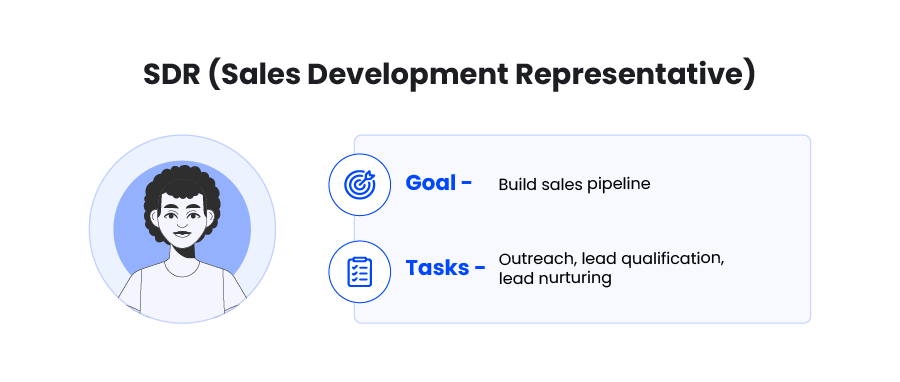
SDRs work with both – outside sales and inside sales teams. Their main job is to qualify leads according to the set criteria and pass on the qualified leads to Account Executives or AEs.
Who is an AE in sales?
AE or Account Executives are responsible for conducting meetings, nurturing the sales pipeline, closing deals, and managing customer interactions.
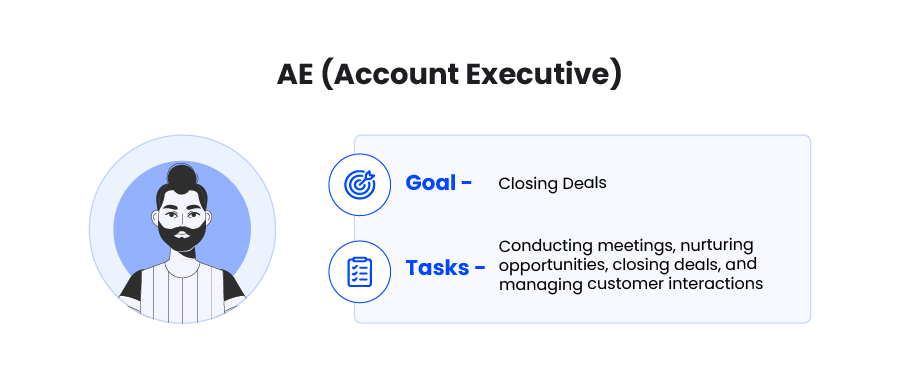
Who is a BDR?
A BDR (Business Development Representative) works on generating new business opportunities by interacting with potential buyers. They do this through cold emailing, cold calling, events, and social media networking.
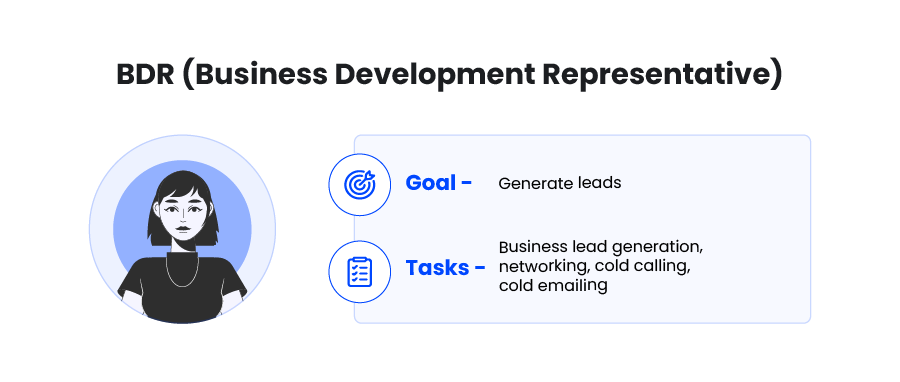
What’s the difference between SDR and BDR?
An SDR helps with the outreach efforts, while a BDR or a Business Development Representative helps generate leads. In other words, a BDR helps to get new business leads, whereas an SDR determines if those leads are worth pursuing or not.
BDR roles generally demand some degree of creativity. For instance, they constantly brainstorm new ideas to find leads. Leads can come from many sources, such as search engine research, networking, making cold calls, social media, and anything the rep can think of.
On the other hand, an SDR has to qualify leads coming in from:
- market research,
- emails,
- newsletter signups,
- clients referrals,
- social media connection, and so on.
In short, the roles of SDRs and BDRs largely depend on how departments are structured and often vary across businesses.
The importance of SDR teams in an organization
As your business grows, you’ll have more lead influx. Amidst this, you’d want to first pursue the leads that can bring the most profits.
But can your sales reps manage more inquiries when they already have targets to meet and leads to pursue?
Probably not.
That’s why you need an SDR team who can:
- Improve the health of your sales pipeline. That is, they ensure that junk or uninterested leads do not enter the sales funnel, and the executives will have only quality leads to follow-up.
- Offload sales executives from dealing with uninterested leads, allowing them to focus more on closing sales. It helps save their time and increases their productivity.
- Drive growth through prospecting, following up with cold leads and reactivating them, and more.
For instance, in LeadSquared, SDRs contribute to the sales process through prospecting, gathering information like buyers’ domains and needs, analyzing product-market fit, setting up demos, etc.
“The most exciting thing in the SDR role is finding the right decision-makers for our product, understanding what they do, how they do it, and how we can help them make their job easier and better.”
Sahil Sansarwal, Team Lead Sales Development – US, LeadSquared
In the next section, we will look at the roles and responsibilities of sales development representatives.
Roles and responsibilities of Sales Development Representatives
Sales development representatives are usually the first point of contact for a prospect. Their communication with the prospective buyers helps develop brand perception.
In general, the day-to-day task or job description of a sales development representative includes:
- Identifying qualified prospects and navigating company structures to identify decision-makers.
- Conducting high-level discovery conversations.
- Using a combination of outreach mechanisms to nurture leads (Call, Email, CRM, Marketing automation tools, etc.) and supporting the demand generation process.
- Generating appointments/meetings through proactive outbound prospecting.
- Working directly with sales and marketing to discover opportunities from leads.
- Meeting or exceeding SDR sourced Sales Accepted Opportunity (SAO) or Sales Qualified Lead (SQL) volume targets.
- Collaborating with teammates to develop targeted lists, call strategies, and messaging to drive opportunities.
- Managing, tracking, and reporting on all activities and results using CRM.
- Attending field marketing events to engage with participants, identify opportunities, and schedule meetings.
Now let us look at the day in the life of a Sales Development Representative.
Responsibilities
1. Lead generation and qualification
Prospecting and lead qualification are the two key functional areas for SDRs.
- They use their network, social selling, and other strategies to generate a sales pipeline.
- They initiate discovery calls with MQLs (marketing qualified leads) to ensure that the sales pipeline comprises only qualified leads.
As every business will have its qualification criteria, SDRs are taught ICP (Ideal Customer Profile) or customer personas during sales training.
At this stage, an SDR must gather information about the prospects by answering the following questions.
- Does the prospect fit into the company’s ideal buyer persona?
- What are their priorities, pain points, or challenges that you can address?
- What are their business goals?
- Who is the decision-maker in the company?
- What tools or solutions will the prospect need to solve their problem?
Using strategies like BANT (Budget, Authority, Need, Timing), SDRs can identify if a lead is worth the time or not.
2. Initial outreach
When an SDR finds a promising lead, they figure out the best way to reach out to them. A lot of that depends on where the lead/prospect spends most of their time. An SDR may reach out via social media, emails, or make a cold call if needed.
While there can be multiple ways to contact a prospect, it is advised not to bombard them with texts across all channels. So, an SDR must think aloud before starting a conversion:
- Should you send a text email or a video email?
- Will talking directly with the person help?
- Should you send a connection request on LinkedIn or approach them over Facebook or Instagram?
If the prospect does not respond on any particular channel, the SDR reaches out to them via other means.
The next part of the outreach is personalizing the communication – whether it is verbal or written.
For instance, SDRs must do their homework about the prospect, address them with their names, and converse in the language they understand.
In the case of reaching out via emails, personalization goes beyond adding the “First name” or “Company Name” to the email. It should be relevant to their work and the solution they’re looking to solve.
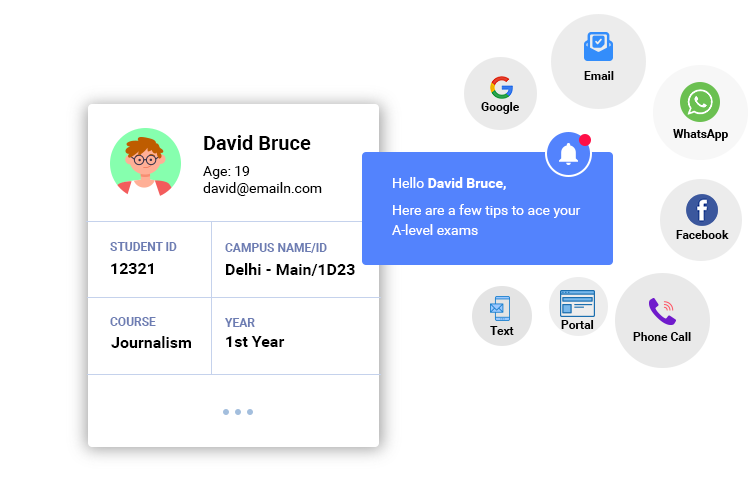
3. Lead nurturing
An SDR is also responsible for generating interest in your offering by keeping the leads engaged throughout the qualification process. For instance, a prospect may be unlikely to meet after the introductory phone call. At that point, an SDR would nurture them and educate them further about the product or the service.
Note that this approach is different from making a product pitch. If everything you say feels like a sales pitch, then the prospect will be unimpressed. However, you will have to help them with their most pressing challenges and offer something of value. When your prospect trusts you, you can be sure that the outcome will be positive.
4. Moving leads through the pipeline
SDRs share qualified leads with the account executives or account managers. The primary role of the SDR is to qualify leads, and most organizations reward SDRs based on this metric. For example, an organization can reward an SDR based on the number of booked meetings with SQLs or sales-qualified leads.
“In LeadSquared, successful SDRs have moved into almost every department in the company and most often continue their career in the sales or account management teams.”
Next, let’s see the tools that make SDRs’ work easy.
SDR Sales Toolkit
As we have seen, the key functional areas of SDRs involve:
- Prospecting
- Lead qualification
- Lead nurturing
- Scheduling meetings and demos
- Lead management
Fortunately, a myriad of tools is available to make their task easy. We’ll list some of the best ones, mostly the ones we use at LeadSquared.
1. Sales prospecting tools
Prospecting involves identifying the potential customers and their contact details.
It might seem easy, but, in reality, SDRs also have to figure out whether they’re the right fit for your business. For instance, they may consider company size, annual spending on marketing, etc.
Below are the best tools for prospecting:
- LinkedIn Sales Navigator. It helps target, track, and engage with prospects. It also easily integrates with LeadSquared CRM to get a complete picture of leads as soon as they enter the sales funnel.
- Getprospect. It helps find email ids from the LinkedIn database.
- Lusha. It helps find phone numbers and mailing addresses apart from email ids.
- Chatbots. Live chat widgets such as Drift also help discover leads looking for some information/solution on your website.
2. Lead qualification tools
Lead qualification is the process of identifying the people who are most likely to make a purchase. It involves assigning lead and engagement scores based on demographic, firmographic, and behavioral data (lead source, website activity, etc.).
Our SDRs use LeadSquared CRM for automated lead qualification.
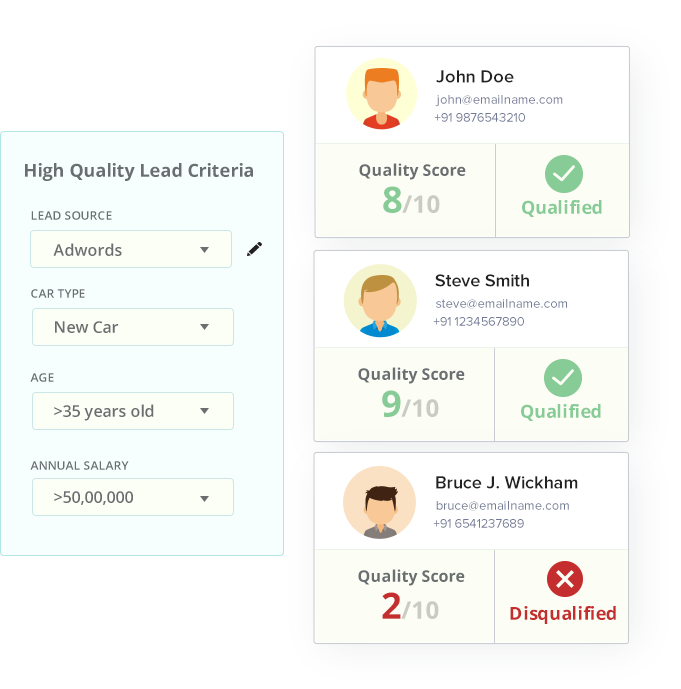
3. Lead nurturing tools
Lead nurturing is the process of engaging with leads to make them sales-ready. It involves calling, sending emails, asking discovery questions, and more.
The best tools to automate lead nurturing are:
- LeadSquared sales execution CRM. It allows creating, managing, and tracking email campaigns, landing pages, etc.
- MailChimp. It is one of the most popular tools for managing email campaigns.
- Cloud calling solutions like RingCentral, CallTrackingMetrics, and more. By integrating these tools with CRM, SDRs can place calls directly from their CRM app. It eliminates the need to dial numbers manually.
4. Meetings and demos scheduling tools
All the above tools help schedule, reschedule, or cancel meetings and send reminder notifications for scheduled meetings/demos.
You can find a list of meeting scheduling tools here.
5. Lead management CRM
“LeadSquared has put us in complete control of our leads. It’s easy to track them, share information between teams and follow up in a timely manner. The sales team is also much more efficient, because they know exactly which leads to contact first.”
Carlene Whitehead, Storm Internet
LeadSquared is the best lead management CRM for high-velocity sales.
It supports automated:
- Lead capture from several sources
- Lead distribution
- Quality and engagement scoring
- Dashboard and reports
Apart from these, it also comes with an inbuilt email campaign and landing page builder and dialers (cloud telephony) and supports out-of-box integration with many third-party apps.
Learn more about latest sales software you can use to increase productivity!
The skills required in an ideal SDR candidate
“SDRs must be able to adapt to this fast-moving environment. Otherwise, they’ll be left behind.”
Rajat Arora, VP – Sales & Marketing, LeadSquared
SDRs need all the traits of a good salesperson. They need a competitive and gritty mindset, a never-say-die attitude, good knowledge of the buyer persona, and proper communication skills. Here are some of the skills that the SDR role demands.
- Research skills: The SDR needs to know the buyer persona well, their goals and challenges, and how the product can solve their problem.
- Creativity: Decision makers generally have their inboxes overflowing with sales pitch emails. SDRs need to be genuinely creative and not just use a script or a mail filled with powerful words to make a good impression.
- A gritty mindset: SDRs need to love their job. Often, they will be handling multiple tasks at once. They will need to juggle between researching prospects, follow-up meets, and outreach efforts. Depending on the organization, these workloads will vary. Management skills are crucial for an SDR role. Having a gritty and yet curious mindset will allow individuals in such positions to shine.
- Familiarity with the industry tools: A familiarity with CRM software, outreach software, and prospecting tools helps potential SDRs get recruited faster.
- Communication skills: SDRs need to be active listeners. Top-performing sales reps listen more than they speak on the sales calls. Also, listening gives SDRs more insight into the buyer preferences that they can utilize while qualifying them for sales.
“I think it’s crazy that we hire for grit, stamina, determination, and perseverance when our customers want someone who’s compassionate, kind, trustworthy, a great listener, and an expert in their field. It’s like there’s almost no overlap between what customers want from a great sales rep and what a VP of Sales wants from a great sales rep. It all comes back down to putting customers first or buyers first.”
Sahil Mansuri, CEO, Bravado
(Source: LinkedIn State of Sales 2021)
So you know now, a blend of the above mentioned skills and listening skills can take you places.
LeadSquared: The best CRM for SDRs
In a recent LinkedIn survey, nearly 71% of respondents said their CRM system was “very important” to closing deals.
CRM software is, in fact, crucial at almost every stage of the sales process. It is also an indispensable tool for SDRs.
LeadSquared is the new-age sales execution CRM purely focused on reducing the total time a sales rep spends on any operational task.
In one of my interviews with a sales team lead, I got to know an interesting fact about LeadSquared.
They said – LeadSquared is much easier to use than Salesforce. Since people join sales from different educational backgrounds, they may not know simple computational logic such as “if-else.” And they shouldn’t have to because their expertise is building relationships. That’s where LeadSquared comes in handy. Reps can easily filter data without any code or computation. They say – “The “Smart Views” feature of LeadSquared is all we need.”
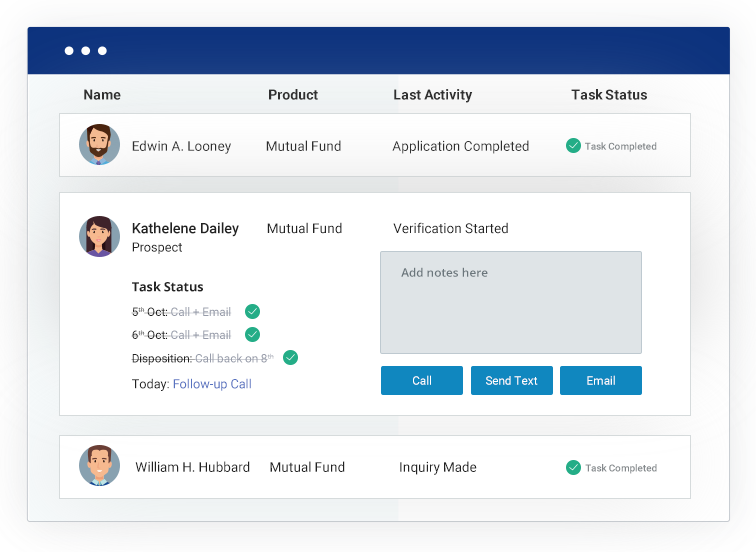
Well, you’ll love LeadSquared for:
- Mobile CRM that allows salespeople to manage their tasks, appointments, document upload, lead transfer, and more on the go. Managers can track their team members’ every move.
- In-built dialers to make calls from the CRM platform itself.
- Smart Views to see only the assigned tasks, leads, and activities. This avoids workplace distractions.
- Efficient lead management and sales automation.
- No-code sales process builder. Users can sketch the best-possible sales workflows for different products and teams.
- Out-of-box integration with lead capture channels, like Google Ads, Facebook, 100s of lead capture sites, cloud calling, ads, Zapier, and many more third-party tools.
- 100+ ready-to-use reports and customizable dashboards.
LeadSquared is the only sales execution CRM for all your products, teams, and processes. Make your team the most productive workforce. Book a demo and see LeadSquared in action.
FAQs
SDR stands for Sales Development Representatives. It is an important function in sales in which sales reps reach out to prospects, qualify inbound leads, nurture them, and build an active sales pipeline.
SDRs focus on one particular role (target buyer) across several companies. In contrast, ADRs target multiple roles (people) across one target account (company).
Depending on an organization’s policies, SDRs may get a commission for business opportunities generated or demos conducted. Read more about sales commission.
In SaaS sales, SDRs generally focus on building a sales pipeline through prospect outreach, lead qualification, and lead nurturing.










